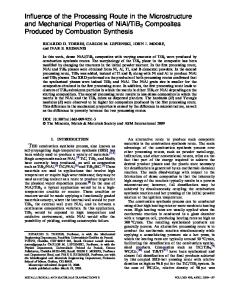Thermomechanical processing of (TiB + TiC)/Ti matrix composites and effects on microstructure and tensile properties
- PDF / 966,487 Bytes
- 10 Pages / 584.957 x 782.986 pts Page_size
- 69 Downloads / 413 Views
aoping Hou Department of Materials Science, School of Materials Science and Engineering, Taiyuan University of Technology, Taiyuan 030024, Shanxi, People’s Republic of China
Fantao Kong and Yuyong Chen National Key Laboratory for Precision Hot Processing of Metals, Harbin Institute of Technology, Harbin 150001, Heilongjiang, People’s Republic of China (Received 18 October 2015; accepted 22 March 2016)
In the paper, 2.5 vol% (TiB 1 TiC)/Ti composite has been fabricated by in situ casting route. 1-D forging and subsequent multistep rolling in (a 1 b) phase field are conducted on the as-cast composite and, accordingly, the matrix microstructure is significantly refined, and the distribution uniformity of reinforcements is greatly improved. The tensile properties of the composites with different processing states are tested at room temperature (RT), 600 and 700 °C. The results indicate that thermomechanical processing (TMP) can drastically improve strength and elongation of the as-cast composite both at RT and 600 °C. As tensile temperature increases to 700 °C, the UTSs of the composites gradually reduce while the elongations of the composites are enhanced remarkably after TMP. The degradation in UTS can be related to the matrix softening and interfacial debonding at 700 °C.
I. INTRODUCTION
Contributing Editor: Jürgen Eckert Address all correspondence to these authors. a) e-mail: [email protected] b) e-mail: [email protected] DOI: 10.1557/jmr.2016.143
improve the mechanical properties of as-cast composites. Recent study by Imayev et al.10 has shown that the Ti–TiB-based composites exhibit much higher strength than matrix alloy without drastic ductility reduction after multiple isothermal 2-D forging. Rastegari et al.11 also found that elongation achieves 10% when the as-cast TiC/Ti–6Al–4V composite undergone direct rolling with a total deformation of 40%. It is noted that the hot working of TMCs mostly concentrated in the b phase field while little attention has been paid to the hot working process in (a 1 b) phase field. Actually, numerous studies12–14 carried out on titanium alloys have revealed that equiaxed and bimodal microstructures can be obtained by TMP in (a 1 b) phase field. And the equiaxed microstructure with good plasticity and low cycle fatigue properties while the bimodal microstructure with good fatigue and creep resistant properties are generally recognized.13,14 Thus, it’s essential to systematically research the microstructure and mechanical properties of (TiB 1 TiC)/Ti composites processed in (a 1 b) phase field. In this study, the 2.5 vol% (TiB 1 TiC)/Ti composite was prepared by in situ casting route then underwent forging and rolling in (a 1 b) phase field. The main objective of the present work was to investigate the relationship among TMP, microstructural evolution, and tensile properties.
1244
Ó Materials Research Society 2016
Specific modulus, high strength, superior creep, and fatigue resistances are the salient features that make titanium matrix composites (TMCs) promising for a variety of appl
Data Loading...











